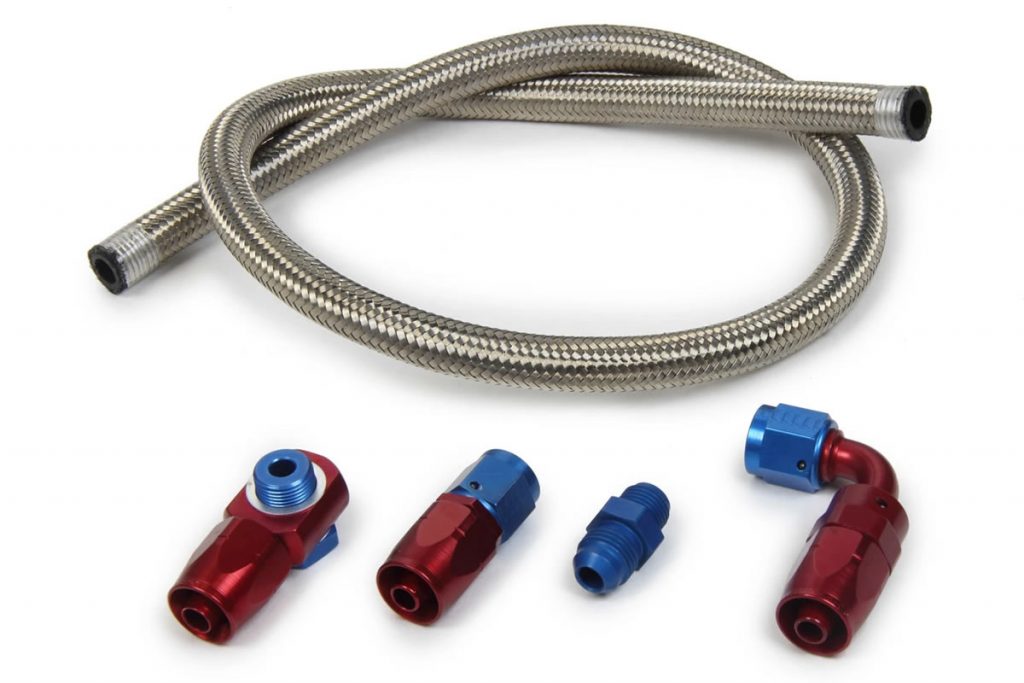The C4 Corvette ZR-1 was one of the rare GM cars which comes with a factory-installed engine oil cooler as standard equipment. It is an air-to-oil unit mounted between the radiator and the air conditioning condenser. It connects to the engine with a set of rubber oil hoses which are constructed like power steering hose, ie: aluminum fittings crimped onto rubber hose.
The original LT5 oil hose design was part of Lotus’ work on the engine and the hose size was specific to the application. GM found out fairly early in the ZR-1’s six-years of production that these lines were prone to leakage, usually where the fittings are crimped to the hose–a common problem with such low-cost construction.
In fact, GM’s warranty cost for this durability problem was high enough that GM Service Parts Operations, released a revised LT5 oil hose assembly about 1992. Typical for SPO, they did this as cheap as possible using an off-shelf hose type, which was smaller in diameter but less prone to leakage.
Back in the late-’90s, during the early stages of the “Purple Project” series of articles for Vette Magazine, I found the oil hoses on my ZR-1 were leaking. I ordered replacement GM hoses. When I compared the diameter of the new hoses to my originals, I laughed out loud and said, “hell with these POSes.” The diameter reduction was so significant that, the oil lines might became a restriction in the oiling system. That’s not a big problem with the engine is running at low loads, the oil temperature is low and the oil thermostat is not passing much oil to the cooler but, run the engine hard such that the oil temp gets up towards 230-250 degrees and the thermostat is wide-open, then you’ve got restriction.
The solution? Junk those stock oil hoses and replace them with Aeroquip. Eaton’s Aeroquip division is one of the few major suppliers of braided stainless steel covered hoses and AN fittings which designs, develops and tests all its products in it’s own, ISO 9001- and QS 9000-certified certified, U.S. plants.
As it turns out, putting Aeroquip oil hoses on an LT5 is, on one hand, relatively easy because the oil fittings on the engine are the same SAE 37¡ compression type used by Aeroquip hoses but is also a bit difficult because, on the cooler end, you need to modify the connection by heliarc welding male AN fittings to the existing hard oil lines.
I selected AN-12 as the hose size I wanted because it has just a bit larger I.D. than the original, Lotus-designed hoses. I cut the rubber hoses off my leaking hose assembly. Then, I cut the pipe ends off two Aeroquip AN-12-to-pipe thread adapters.
The modified fittings MUST be heliarc welded to the aluminum oil pipes. Unless you have advanced welding skills and access to TIG welding equipment, I suggest you do like I did and farm the job out to a welding or fabrication shop experienced with welding small aluminum parts. I chose Hansen Race cars, a drag racing chassis builder in Montclair, California. A high-end, full-service racing chassis shop, such as Hansen’s, will have the aluminum welding skills required for this job. Other places to look for small-parts, heliarc welding skills are specialty welders doing aircraft work (look for them near airports) or radiator shops having skills in aluminum radiator repair.
Gary Hansen handled my welding job himself and made short work of the task, mainly because I came in with the fittings already machined and the aluminum tubes – surfaces already sanded. Hansen is a veteran heliarc operator and knows how to make pinhole free welds look easy. After the fittings are welded on the lines, they need to be pressure checked. This is easy if you have a AN-10 female cap, an air compressor capible of 90-100 psi and a bottle of 409. Cap-off one end of the line, stick an air pressure gun in the other then have an assistant spray the weld with 409. If the weld is leaking, the 409 will bubble. None of Hansen’s welds leaked. Back at my shop, after the visit to Hansen Race Cars (4054 Mission Bl., Montclair, CA 91763, ph: 909 626 6967), I bolted the modified aluminum tubes to the oil cooler.
Then I built two, short AN-12 hoses using Aeroquip AN-12 AQP Racing Hose and four, 45¡ AQP Reusable fittings. After that, it was a simple process to install my new Aeroquip oil hoses between the engine and the cooler.
I built these lines in 1998 and, since then, those Aeroquip hoses have run nearly, 50,000 leak-free miles. Plus…they look damn cool when you open the hood.
For more information on Aeroquip Products see: https://www.eaton.com/Eaton/ProductsServices/ProductsbyName/Aeroquip/RelatedAeroquipproducts/

